sensor TOYOTA SEQUOIA 2022 Service Manual
[x] Cancel search | Manufacturer: TOYOTA, Model Year: 2022, Model line: SEQUOIA, Model: TOYOTA SEQUOIA 2022Pages: 592, PDF Size: 10.82 MB
Page 302 of 592
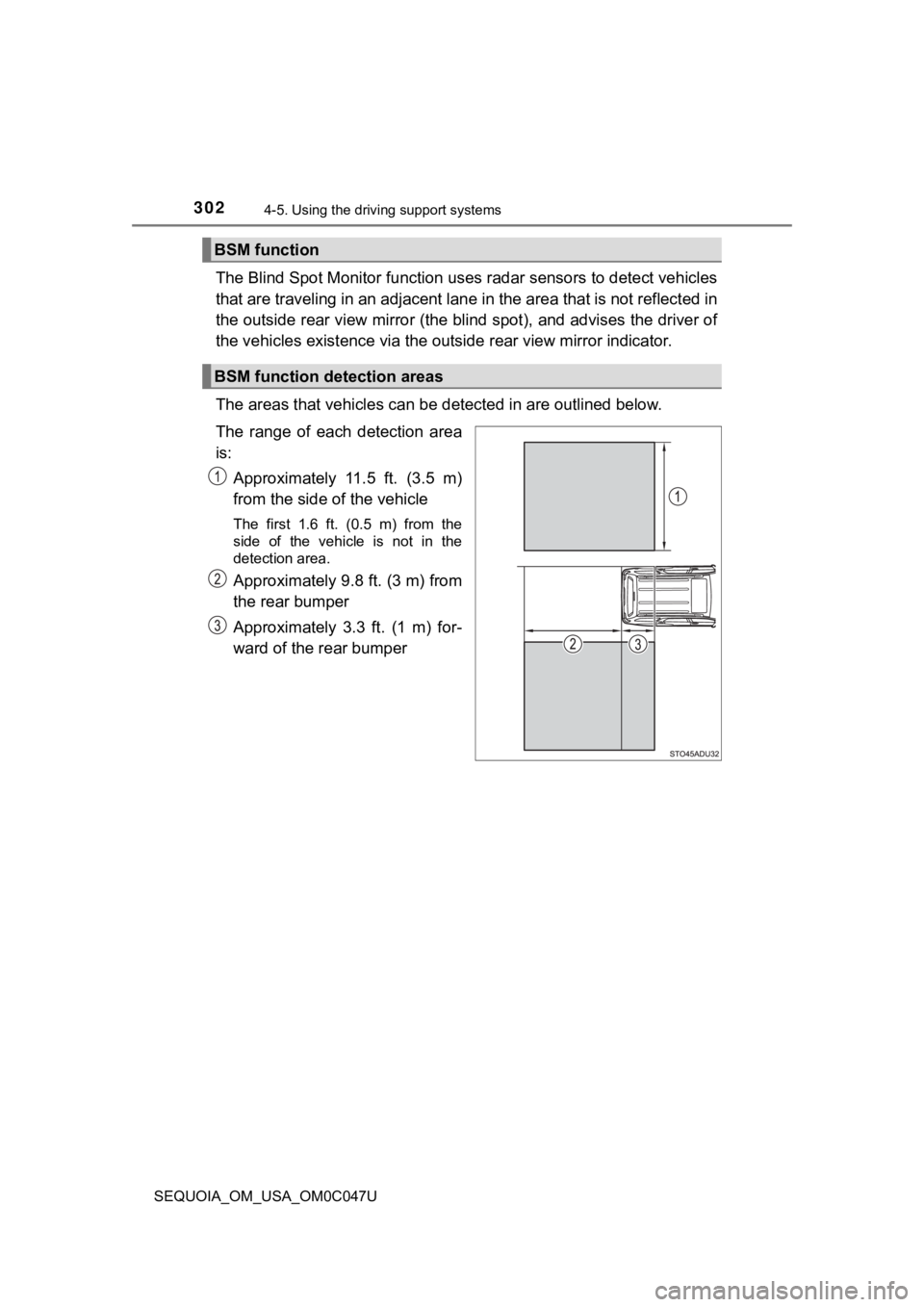
3024-5. Using the driving support systems
SEQUOIA_OM_USA_OM0C047U
The Blind Spot Monitor function uses radar sensors to detect ve hicles
that are traveling in an adjacent lane in the area that is not reflected in
the outside rear view mirror (the blind spot), and advises the driver of
the vehicles existence via the outside rear view mirror indicat or.
The areas that vehicles can be detected in are outlined below.
The range of each detection area
is: Approximately 11.5 ft. (3.5 m)
from the side of the vehicle
The first 1.6 ft. (0.5 m) from the
side of the vehicle is not in the
detection area.
Approximately 9.8 ft. (3 m) from
the rear bumper
Approximately 3.3 ft. (1 m) for-
ward of the rear bumper
BSM function
BSM function detection areas
Page 305 of 592

3054-5. Using the driving support systems
4
Driving
SEQUOIA_OM_USA_OM0C047U
The RCTA functions when your vehicle is in reverse. It can detect
other vehicles approaching from the right or left rear of the vehicle. It
uses radar sensors to alert the driver of the other vehicle’s existence
through flashing the outside rear view mirror indicators and so unding
a buzzer.
RCTA function
Approaching vehicles Detection areas
WARNING
■ Cautions regarding the use of the system
There is a limit to the degree of recognition accuracy and cont rol perfor-
mance that this system can provide, do not overly rely on this system. The
driver is always responsible for paying attention to the vehicl e’s surround-
ings and driving safely. ( P. 303)
■ To ensure the system can operate properly
P. 301
Page 307 of 592
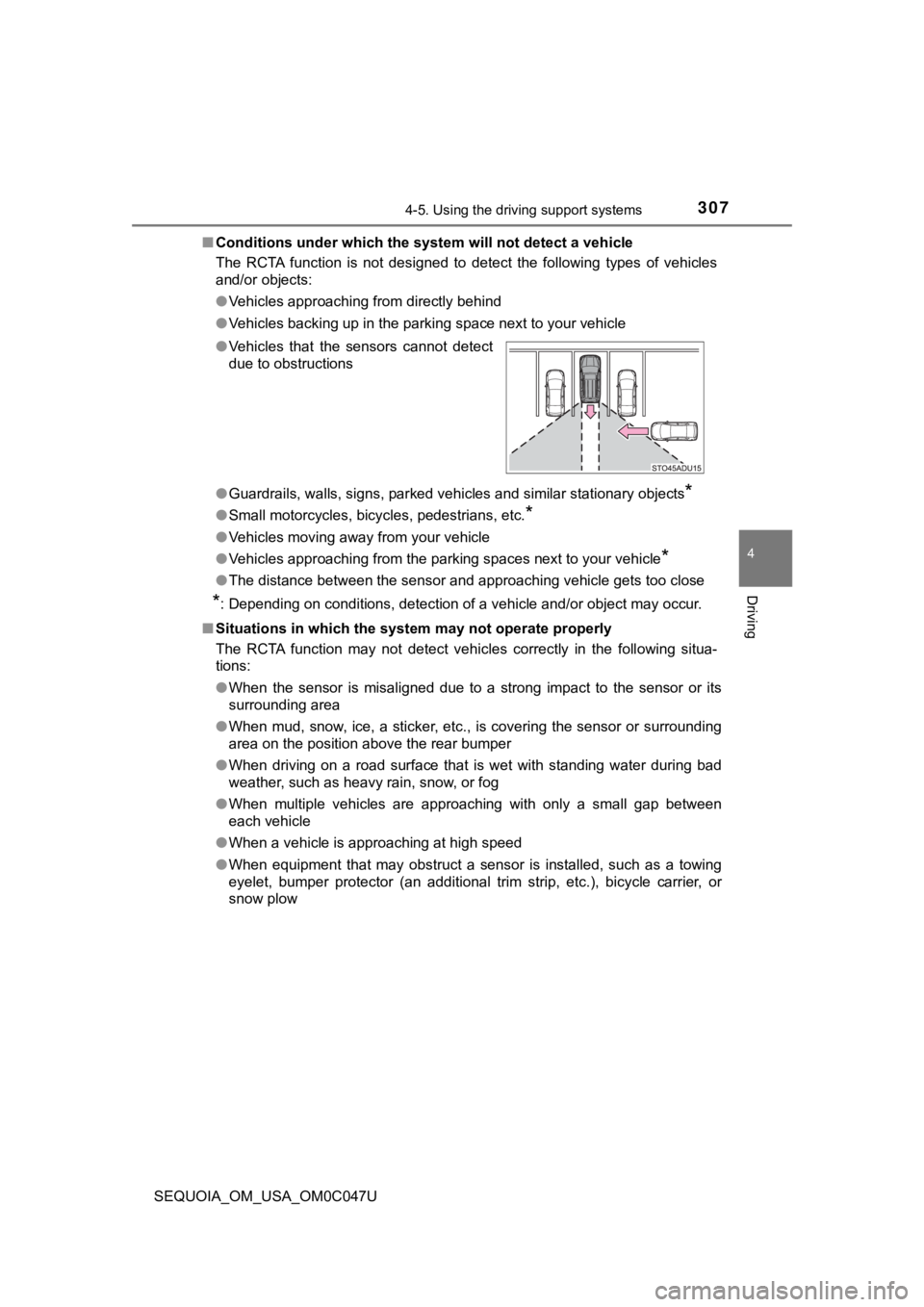
3074-5. Using the driving support systems
4
Driving
SEQUOIA_OM_USA_OM0C047U■
Conditions under which the system will not detect a vehicle
The RCTA function is not designed to detect the following types of vehicles
and/or objects:
● Vehicles approaching from directly behind
● Vehicles backing up in the parking space next to your vehicle
● Guardrails, walls, signs, parked vehicles and similar stationar y objects
*
●Small motorcycles, bicycles, pedestrians, etc.*
●Vehicles moving away from your vehicle
● Vehicles approaching from the parking spaces next to your vehic le
*
●The distance between the sensor and approaching vehicle gets to o close
*: Depending on conditions, detection of a vehicle and/or object may occur.
■ Situations in which the syst em may not operate properly
The RCTA function may not detect vehicles correctly in the foll owing situa-
tions:
● When the sensor is misaligned due to a strong impact to the sensor or its
surrounding area
● When mud, snow, ice, a sticker, etc., is covering the sensor or surrounding
area on the position above the rear bumper
● When driving on a road surface that is wet with standing water during bad
weather, such as heavy rain, snow, or fog
● When multiple vehicles are approaching with only a small gap be tween
each vehicle
● When a vehicle is approaching at high speed
● When equipment that may obstruct a sensor is installed, such as a towing
eyelet, bumper protector (an additional trim strip, etc.), bicy cle carrier, or
snow plow
●
Vehicles that the sensors cannot detect
due to obstructions
Page 308 of 592
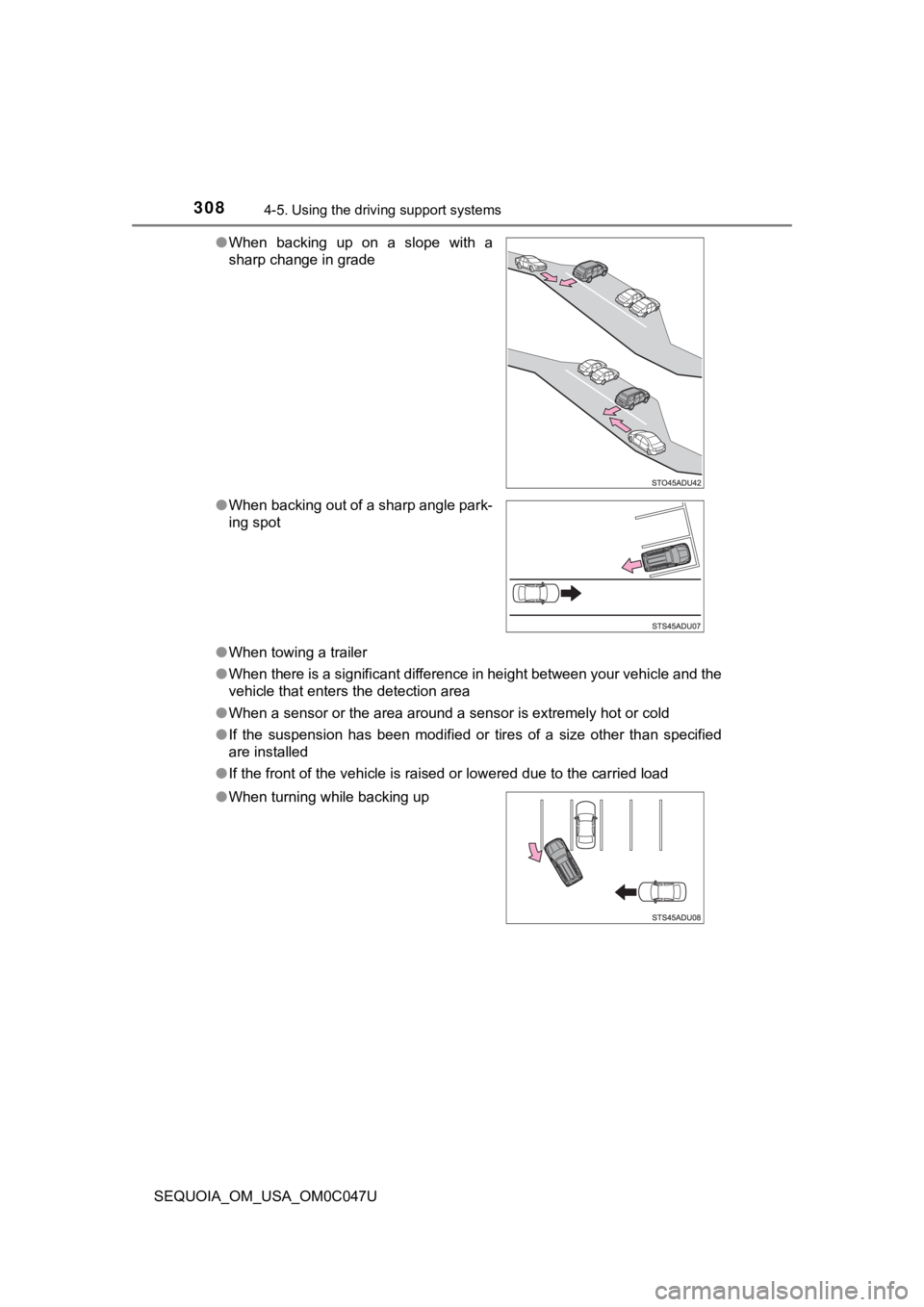
3084-5. Using the driving support systems
SEQUOIA_OM_USA_OM0C047U●
When towing a trailer
● When there is a significant difference in height between your vehicle and the
vehicle that enters the detection area
● When a sensor or the area around a sensor is extremely hot or c old
● If the suspension has been modified or tires of a size other th an specified
are installed
● If the front of the vehicle is raised or lowered due to the car ried load
●
When backing up on a slope with a
sharp change in grade
● When backing out of a sharp angle park-
ing spot
● When turning while backing up
Page 309 of 592
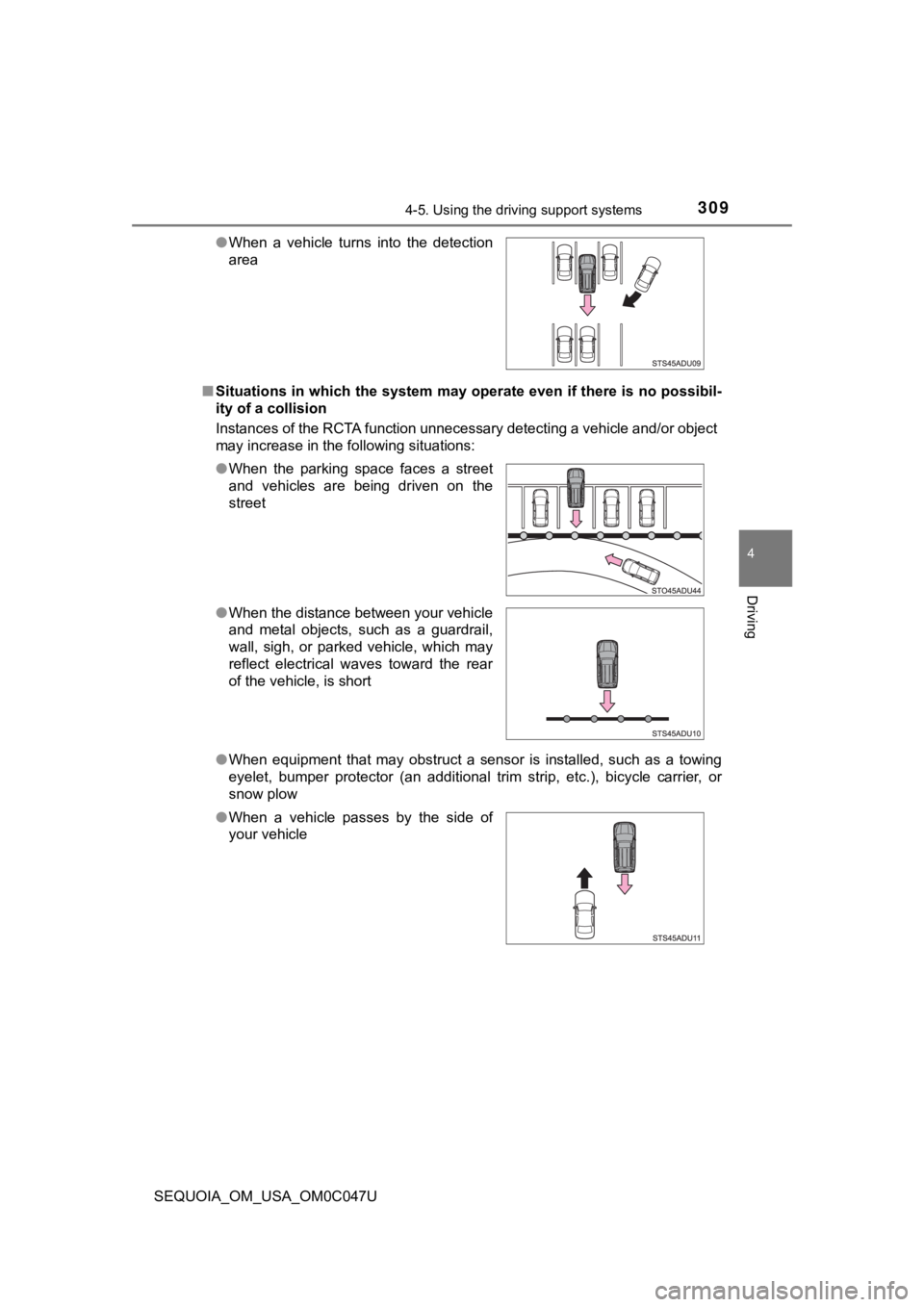
3094-5. Using the driving support systems
4
Driving
SEQUOIA_OM_USA_OM0C047U■
Situations in which the system may operate even if there is no possibil-
ity of a collision
Instances of the RCTA function unnecessary detecting a vehicle and/or object
may increase in the following situations:
● When equipment that may obstruct a sensor is installed, such as a towing
eyelet, bumper protector (an additional trim strip, etc.), bicy cle carrier, or
snow plow
●
When a vehicle turns into the detection
area
● When the parking space faces a street
and vehicles are being driven on the
street
● When the distance between your vehicle
and metal objects, such as a guardrail,
wall, sigh, or parked vehicle, which may
reflect electrical waves toward the rear
of the vehicle, is short
● When a vehicle passes by the side of
your vehicle
Page 310 of 592

3104-5. Using the driving support systems
SEQUOIA_OM_USA_OM0C047U●
When there are spinning objects near your vehicle such as the f an of an air
conditioning unit
● When water is splashed or sprayed toward the rear bumper, such as from a
sprinkler
● Moving objects (flags, exhaust fumes, large rain droplets or snowflakes, rain
water on the road surface, etc.)
● When the distance between your vehicle and a guardrail, wall, etc., that
enters the detection area is short
● Gratings and gutters
● When a sensor or the area around a sensor is extremely hot or c old
● If the suspension has been modified or tires of a size other th an specified
are installed
● If the front of the vehicle is raised or lowered due to the car ried load
●
When a detected vehicle turns while
approaching the vehicle
Page 398 of 592
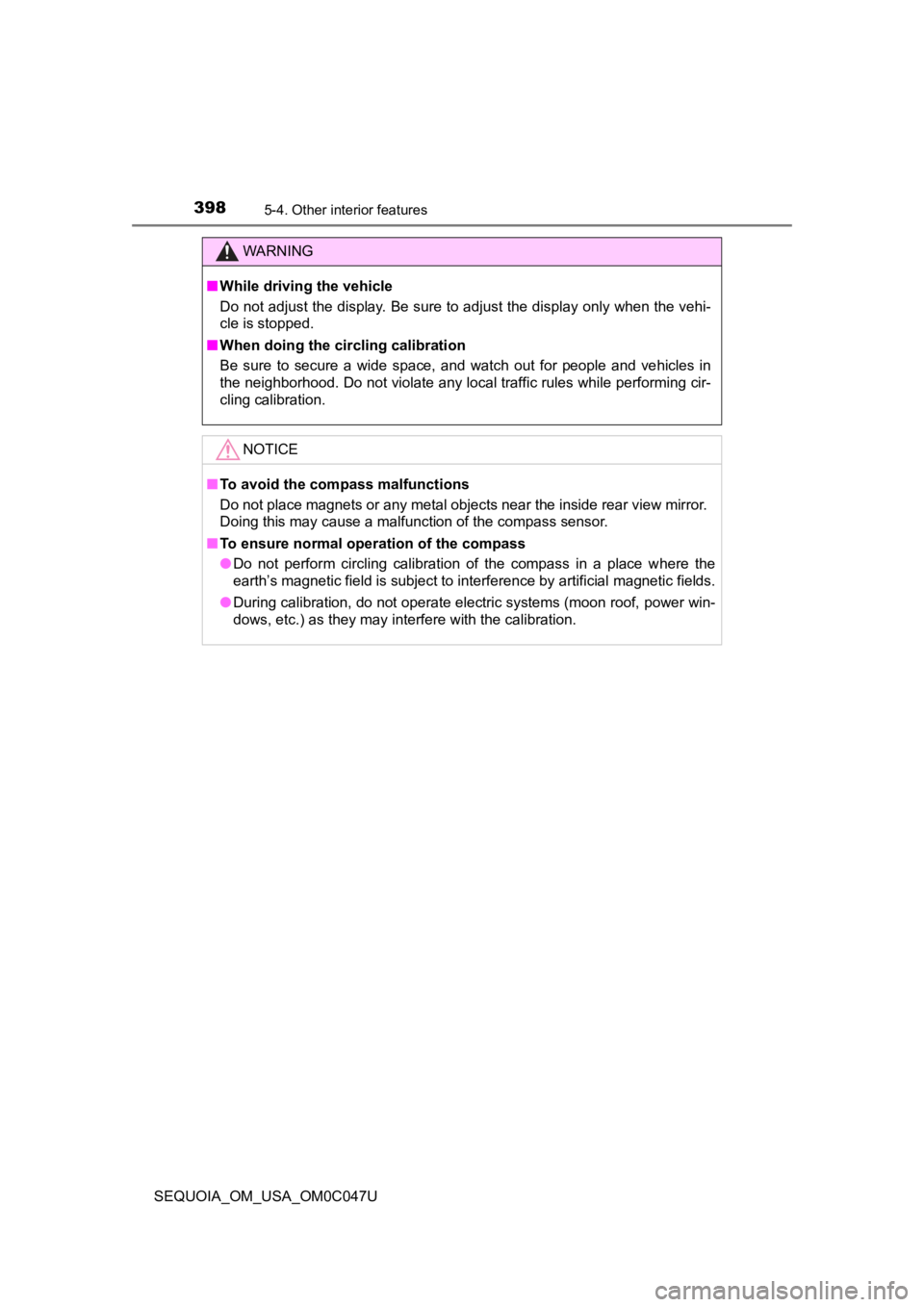
3985-4. Other interior features
SEQUOIA_OM_USA_OM0C047U
WARNING
■While driving the vehicle
Do not adjust the display. Be sure to adjust the display only when the vehi-
cle is stopped.
■ When doing the circling calibration
Be sure to secure a wide space, and watch out for people and vehicles in
the neighborhood. Do not violate any local traffic rules while performing cir-
cling calibration.
NOTICE
■To avoid the compass malfunctions
Do not place magnets or any metal objects near the inside rear view mirror.
Doing this may cause a malfunction of the compass sensor.
■ To ensure normal operation of the compass
● Do not perform circling calibration of the compass in a place w here the
earth’s magnetic field is subject to interference by artificial magnetic fields.
● During calibration, do not operate electric systems (moon roof, power win-
dows, etc.) as they may interfere with the calibration.
Page 476 of 592
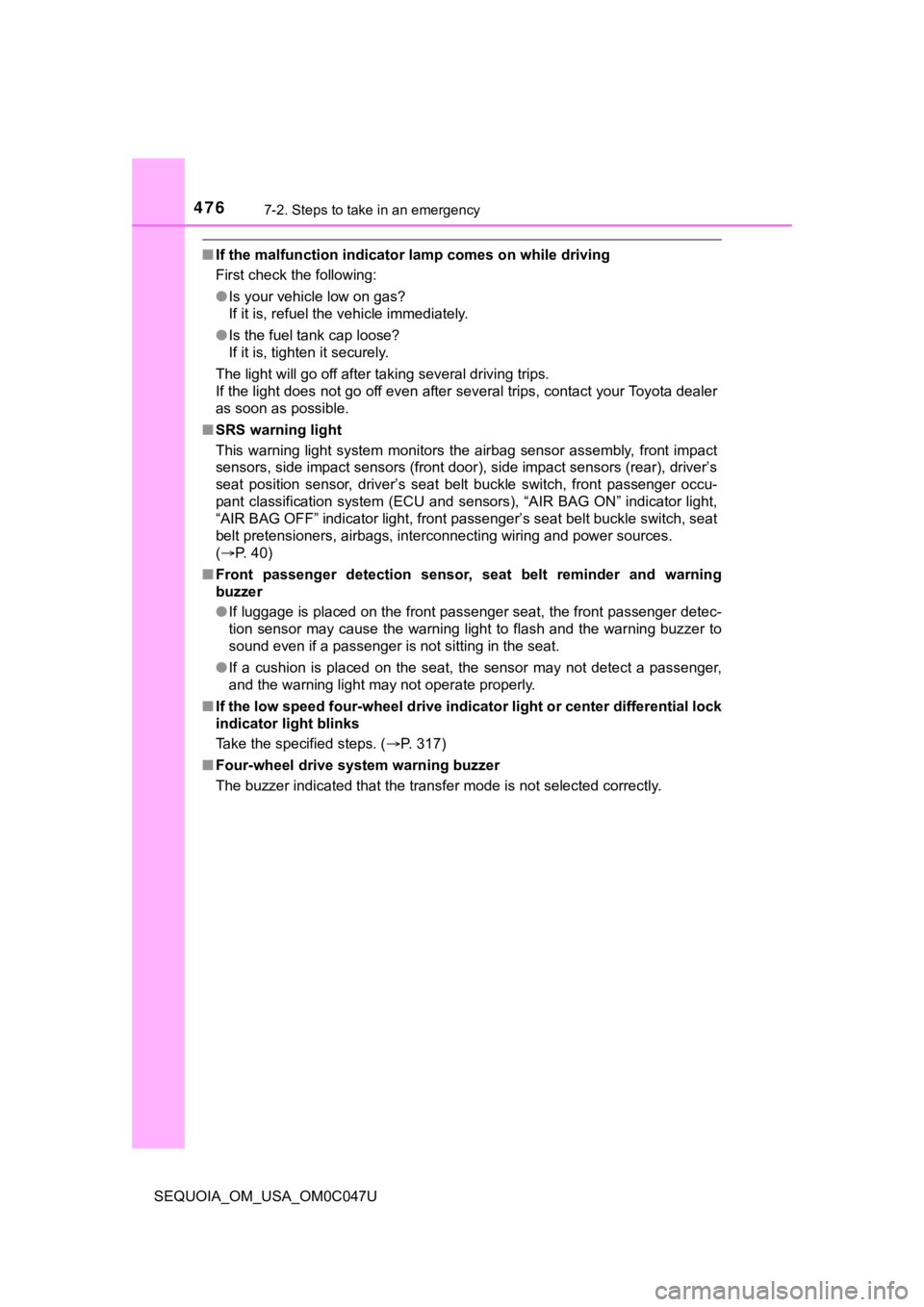
4767-2. Steps to take in an emergency
SEQUOIA_OM_USA_OM0C047U
■If the malfunction indicator lamp comes on while driving
First check the following:
●Is your vehicle low on gas?
If it is, refuel the vehicle immediately.
● Is the fuel tank cap loose?
If it is, tighten it securely.
The light will go off after taking several driving trips.
If the light does not go off even after several trips, contact your Toyota dealer
as soon as possible.
■ SRS warning light
This warning light system monitors the airbag sensor assembly, front impact
sensors, side impact sensors (front door), side impact sensors (rear), driver’s
seat position sensor, driver’s seat belt buckle switch, front passenger occu-
pant classification system (ECU and sensors), “AIR BAG ON” indi cator light,
“AIR BAG OFF” indicator light, front passenger’s seat belt buck le switch, seat
belt pretensioners, airbags, interconnecting wiring and power s ources.
( P. 40)
■ Front passenger detection sensor, seat belt reminder and warnin g
buzzer
● If luggage is placed on the front passenger seat, the front pas senger detec-
tion sensor may cause the warning light to flash and the warnin g buzzer to
sound even if a passenger is not sitting in the seat.
● If a cushion is placed on the seat, the sensor may not detect a passenger,
and the warning light may not operate properly.
■ If the low speed four-wheel drive indicator light or center dif ferential lock
indicator light blinks
Take the specified steps. ( P. 317)
■ Four-wheel drive system warning buzzer
The buzzer indicated that the transfer mode is not selected cor rectly.
Page 482 of 592
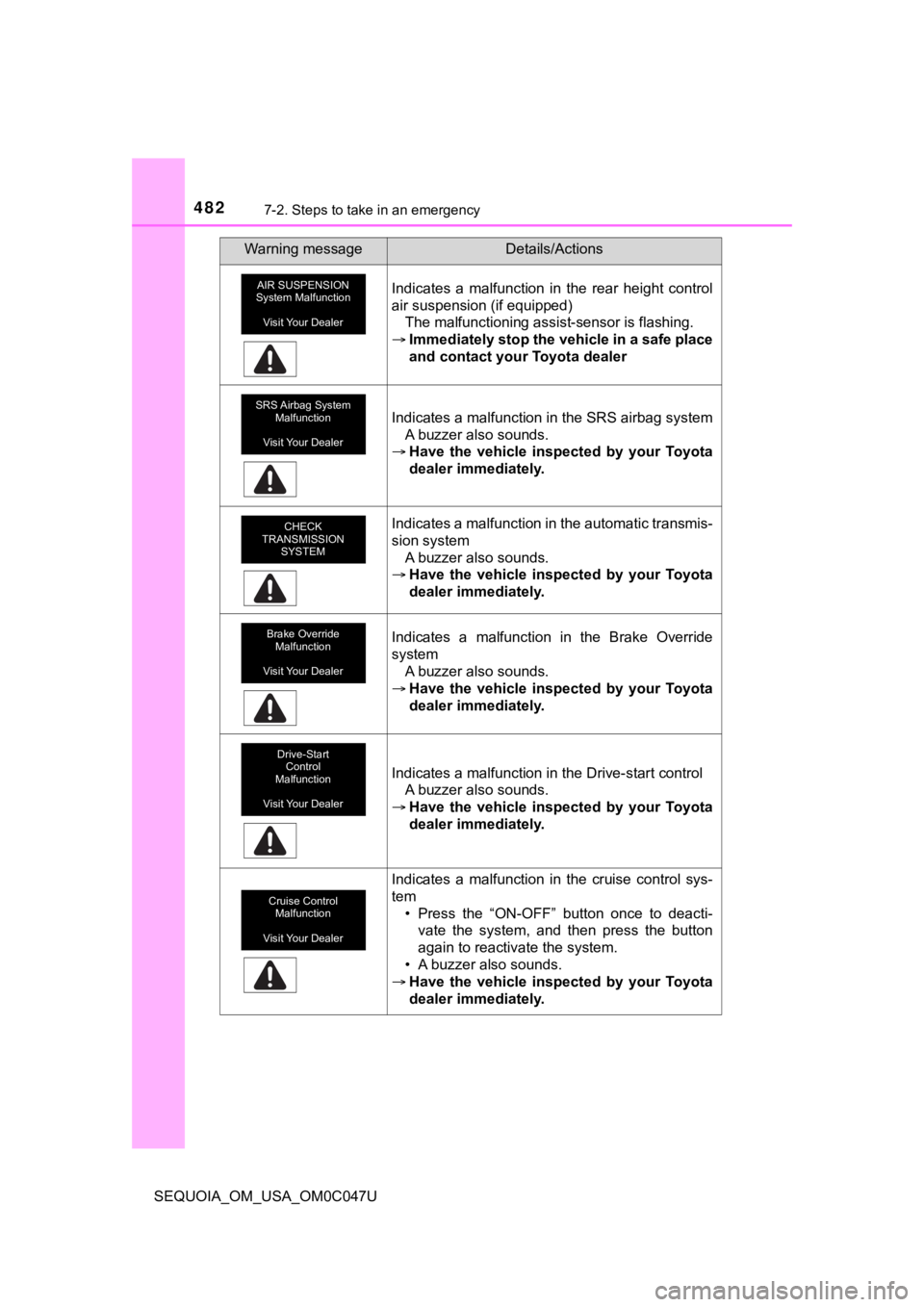
4827-2. Steps to take in an emergency
SEQUOIA_OM_USA_OM0C047U
Indicates a malfunction in the rear height control
air suspension (if equipped)The malfunctioning assist-sensor is flashing.
Immediately stop the vehicle in a safe place
and contact your Toyota dealer
Indicates a malfunction in the SRS airbag system
A buzzer also sounds.
Have the vehicle inspected by your Toyota
dealer immediately.
Indicates a malfunction in the automatic transmis-
sion system
A buzzer also sounds.
Have the vehicle inspected by your Toyota
dealer immediately.
Indicates a malfunction in the Brake Override
system
A buzzer also sounds.
Have the vehicle inspected by your Toyota
dealer immediately.
Indicates a malfunction in the Drive-start control
A buzzer also sounds.
Have the vehicle inspected by your Toyota
dealer immediately.
Indicates a malfunction in the cruise control sys-
tem
• Press the “ON-OFF” button once to deacti-vate the system, and then press the button
again to reactivate the system.
• A buzzer also sounds.
Have the vehicle inspected by your Toyota
dealer immediately.
Warning messageDetails/Actions
AIR SUSPENSION
System Malfunction
Visit Your Dealer
SRS Airbag System Malfunction
Visit Your Dealer
CHECK
TRANSMISSION SYSTEM
Brake Override Malfunction
Visit Your Dealer
Drive-Start Control
Malfunction
Visit Your Dealer
Cruise Control Malfunction
Visit Your Dealer
Page 483 of 592
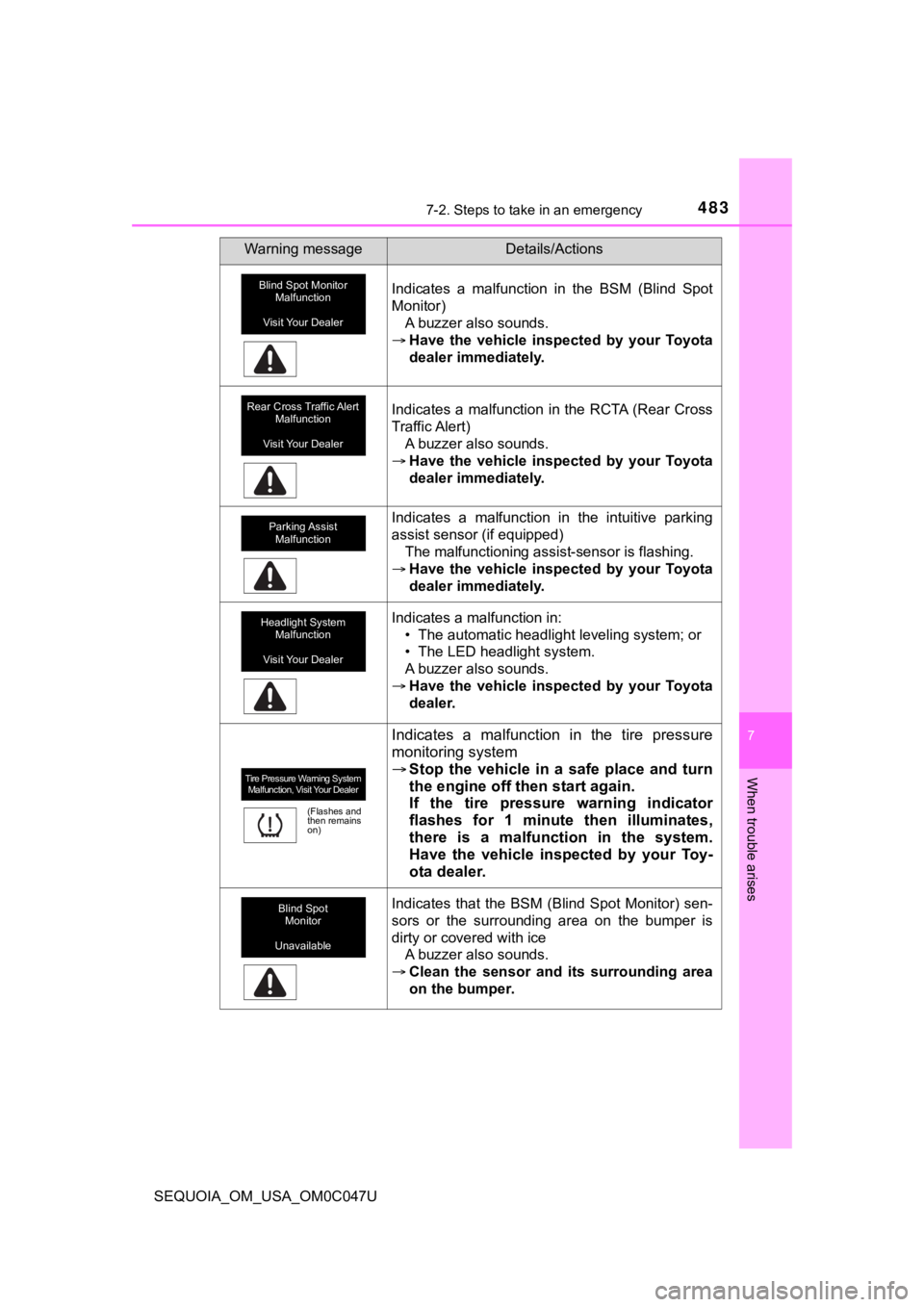
4837-2. Steps to take in an emergency
7
When trouble arises
SEQUOIA_OM_USA_OM0C047U
Indicates a malfunction in the BSM (Blind Spot
Monitor)A buzzer also sounds.
Have the vehicle inspected by your Toyota
dealer immediately.
Indicates a malfunction in the RCTA (Rear Cross
Traffic Alert)
A buzzer also sounds.
Have the vehicle inspected by your Toyota
dealer immediately.
Indicates a malfunction in the intuitive parking
assist sensor (if equipped)
The malfunctioning assist-sensor is flashing.
Have the vehicle inspected by your Toyota
dealer immediately.
Indicates a malfunction in:
• The automatic headlight leveling system; or
• The LED headlight system.
A buzzer also sounds.
Have the vehicle inspected by your Toyota
dealer.
Indicates a malfunction in the tire pressure
monitoring system
Stop the vehicle in a safe place and turn
the engine off then start again.
If the tire pressure warning indicator
flashes for 1 minute then illuminates,
there is a malfunction in the system.
Have the vehicle inspected by your Toy-
ota dealer.
Indicates that the BSM (Blind Spot Monitor) sen-
sors or the surrounding area on the bumper is
dirty or covered with ice
A buzzer also sounds.
Clean the sensor and its surrounding area
on the bumper.
Warning messageDetails/Actions
Blind Spot Monitor Malfunction
Visit Your Dealer
Rear Cross Traffic Alert Malfunction
Visit Your Dealer
Parking Assist Malfunction
Headlight System Malfunction
Visit Your Dealer
Tire Pressure Warning System Malfunction, Visit Your Dealer
(Flashes and
then remains
on)
Blind Spot Monitor
Unavailable